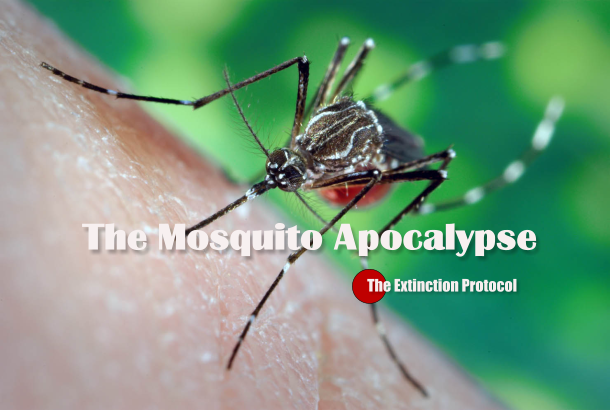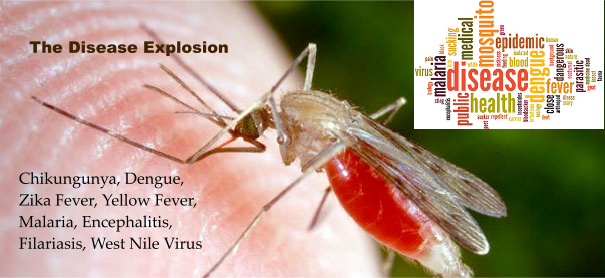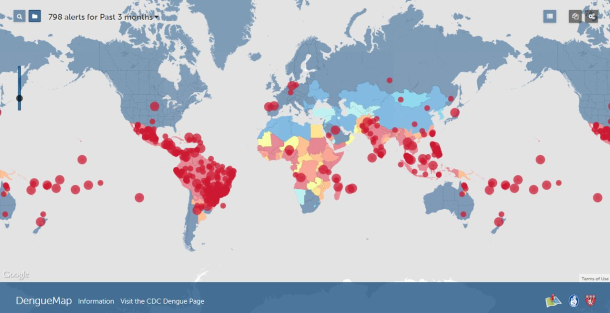skip to main |
skip to sidebar
The Mosquito Disease Explosion: Experts warn the Yellow Fever outbreak in Africa is a ticking time bomb

April 2016 – AFRICA – A
fast-spreading outbreak of yellow fever has taken hold in central
Africa, alarming infectious disease experts and threatening to spread
far wider if not brought under control quickly. Even as the spread of
another virus, Zika, commands the attention of global health officials,
yellow fever could prove far more worrisome. The disease, which like
Zika is transmitted by mosquitoes, kills an estimated 60,000 people a
year. “I think we’re sitting on a time bomb,” Duane Gubler, one of the
world’s leading experts on mosquito-spread viruses, told STAT. “You
think SARS was bad? This would make it pale by comparison.”
The outbreak started in Angola’s
capital, Luanda, in December, and has spread to six of the country’s 18
provinces. Case numbers are not thought to be precise, but the most
recent reports from the World Health Organization suggest 450 people
have been infected and 225 have died. To put that in context, it often
takes only a single diagnosis of yellow fever for a city to launch an
emergency response, said Dr. Sylvie Briand, director of the WHO’s
department of pandemic and epidemic diseases. Already, people infected
in Angola have made their way to Kenya, Mauritania, the Democratic
Republic of Congo, and China — underscoring the fact that the virus is
unlikely to stay put if the outbreak is not brought under control.
There is no cure for yellow fever, but
there is a vaccine that protects people against it. It is, however, in
very short supply. The WHO has sent its entire vaccine stockpile — 6
million doses — to Angola, which would like to vaccinate its population
of nearly 20 million people. “Luanda is 7.2 million inhabitants. So
already it’s more than what we have in the emergency stockpile,” said
Briand. “It’s all gone.” Briand told STAT that the WHO has asked Angola
to hold off on its plan to vaccinate the entire country for a month or
two, until more vaccine is available. As of last week, 5.7 million
people had been vaccinated.
Yellow fever is related to both Zika
and dengue. Zika infection during pregnancy can trigger birth defects in
the fetus. And dengue infection can be life-threatening in a small
proportion of cases. But yellow fever is in a class of its own, experts
say. An initial phase — characterized by fever and the aches and pains
common to dengue, chikungunya, and other similar viruses — is followed
by a so-called toxic phase in about 15 percent of cases. About half of
people who develop the severe form die, the WHO said. The severe form of
the disease can cause internal bleeding and organ failure. It can also
cause jaundice, which is what gives yellow fever its name.

“It’s a very bad disease,” Briand said.
“Even if not all the patients die, the ones with the severe form are
really likely to die, especially in countries like Angola,” where access
to advanced medical care is limited. If yellow fever takes hold in
urban populations of Aedes aegypti mosquitoes, the world will have a big
problem on its hands. “If you had a major outbreak in capital cities,
it would be very difficult to control in due time. And it’s very hard to
prevent people from traveling. So it would be very, very difficult,”
Briand said. The yellow fever vaccine is highly effective. But it is not
made in large quantities because demand for it hasn’t existed in the
recent past. In fact, in the early 2000s manufacturers — only four in
the world make yellow fever vaccine — were talking about scaling back
production.
Briand, who was then leading the WHO’s
yellow fever program, convinced GAVI — the international vaccine
alliance — to finance mass vaccination efforts in countries at high risk
of having outbreaks. It was both a means of lowering the risk and
stabilizing the market for the vaccine. “Many countries didn’t want to
buy the vaccine because they couldn’t see the risk,” she said.
Gubler said he’s been pressing the
largest manufacturer of yellow fever vaccine, Sanofi Pasteur, for years
to stockpile more yellow fever vaccine. The company, which sent 4
million doses of vaccine to Angola through UNICEF, has recently received
the green light to produce in a newly constructed facility in France
that will double its output. It has released 415 million doses of its
yellow fever vaccine, Stamaril, over the past 30 years, a spokesperson
said. Gubler, though, foresees a need for much, much more. So does Jack
Woodall, one of the founders of ProMED — the Program for Monitoring
Emerging Diseases — an Internet-based reporting system run under the
auspices of the International Society for Infectious Diseases.

In a recent ProMED post, Woodall — who
used to work at the WHO and is a former director of the Centers for
Disease Control’s dengue operation — didn’t mince words about the
dangers he sees in the current situation. “If yellow fever were to
spread in Asia, where 2 billion are at risk in 18 dengue-affected
countries, hundreds of thousands could die before yellow fever vaccine
stocks could be boosted and delivered,” he wrote.
“Apocalyptic forecasts of the numbers
of fatalities from Ebola turned out to be wildly wrong, and we can hope
that will again be the case here, but given the way Zika has exploded in
the Western hemisphere, we can’t count on it,” Woodall added. –Stat News








0 comments:
Post a Comment